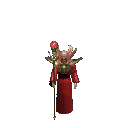
The legend of King Arthur
Contea di Camelot

|
Merlin finding the infant Arthur on the beach at Tintagel. This steel engraving by Gustave Doré is fron 1867 illustrated edition of Lord Tennyson's The idylls of the King. In Guinevere the poet embroiders Geoffrey of Monmouth's fanciful connection between Arthur and Tintagel in his History of the Kings of Britain: ...But after tempest, when the long wave broke All down the thundering shores of Bude and Bos, There came a day as still as heaven, and then They found a naked child upon the sands Of dark Tintagil by the Cornish sea; And that was Arthur; and they foster'd him Till he by miracle approven King... |
|
|
|
This is the battlemented north wall of the thirteenth-century Inner Ward. |
|
Right This present-day aerial photograph clearly shows the narrow neck of land joining the island to mainland |
|
|
|
The castle in legend. Tin-tagell. "Tin" or 'Din' means fortress or fortifiable place, and 'Tagell' may mean a constriction or narrows, the neck of the island. We can guess this is the major belief, a belief quite probably rooted in long-ago fact - that Tintagel had been a royal fortress of the ancient kings or rules of Cornwall. In one set of stories, which became very popular on the Continent, the Island held the palace of King Mark, whose nephew Tristan fell in love with and eloped with Isolt, his uncle's chosen bride. Geoffrey of Monmouth who published "History of the Kings of Britain" 1139, had a different story, the palace belonged to Gorlois, Duke of Cornwall, whose beautifull wife Igerna aroused the love of King Uther Pendragon. Uther besieged Tintagel and then, aided by magician Merlin who chanded him into semblance of Gorlois, made his way secretaly into castle at night and seduced Igerna, who subsequently gave birth to Arthur. Arthur figures, very obscurely, in the post-Roman legends of all Celtic British areas; but as a roving war-leader, never as a King. |